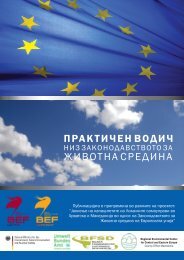The Russian system of chemicals management - Bef-de.org
The Russian system of chemicals management - Bef-de.org
The Russian system of chemicals management - Bef-de.org
Create successful ePaper yourself
Turn your PDF publications into a flip-book with our unique Google optimized e-Paper software.
4.3. Registration and classification <strong>of</strong> mixtures<br />
According to the Fe<strong>de</strong>ral Law <strong>of</strong> March 30, 1999 No. 52-FЗ “On sanitary and epi<strong>de</strong>miological<br />
welfare <strong>of</strong> the population” the specific types <strong>of</strong> products for which registration is<br />
obligatory, are materials, equipment, appliances and other technical facilities for purification<br />
<strong>of</strong> water, inten<strong>de</strong>d for use in water supply <strong>system</strong>s for industrial and household<br />
needs, disinfecting, disinsection and <strong>de</strong>ratization <strong>chemicals</strong> used in household, medical<br />
treatment and prophylactic institutions and other facilities to ensure safety and health <strong>of</strong><br />
people Household <strong>chemicals</strong>.<br />
<strong>The</strong> Government Regulation <strong>of</strong> April 4, 2001 N. 262 “On state registration for specific types<br />
<strong>of</strong> products posing potential threats to human health, аs well as specific types <strong>of</strong> products imported<br />
in the territory <strong>of</strong> <strong>Russian</strong> Fe<strong>de</strong>ration for the first time” further specifies the above list.<br />
<strong>The</strong> registration <strong>of</strong> mixtures (products) is performed by regional <strong>de</strong>partments <strong>of</strong> RosPotrebNadzor.<br />
Chemical products which are subject to registration must have a sanitarytechnical<br />
assessment <strong>of</strong> the production, the use and the disposal. Based on this assessment,<br />
the Public Health Protection Service issues a hygienic certificate for a product.<br />
<strong>The</strong> assessment procedure performed for a mixture is based on its components is similar<br />
to the substance registration:<br />
>> Literature search: hygienic norms, data on homological rows <strong>of</strong> <strong>org</strong>anic substances,<br />
norms <strong>of</strong> other countries, toxicological parameters, predicted or calculated<br />
concentrations for the substances in the mixture as well as the mixture as such<br />
>> <strong>The</strong> need for further assessment <strong>de</strong>pends on the purpose <strong>of</strong> the assessment, e.g.<br />
if a mixture with known ingredients and known toxicity is assessed in or<strong>de</strong>r to establish<br />
a new purpose <strong>of</strong> use– no tests are carried out.<br />
>> If there is suspicion that a mixture contains unevealed components or additive / synergetic<br />
toxicological effects could be presumed – tests are conducted to obtain data.<br />
<strong>The</strong> stage <strong>of</strong> testing is relatively simple (express techniques are applied to test mixtures)<br />
and is taking into account the economic feasibility (including amount <strong>of</strong> product produced):<br />
certain limit tests are carried out, e.g. test on integrated toxicity with daphnia.<br />
A risk based approach is implemented in elaborating the testing plan for a product: the<br />
extent <strong>of</strong> testing <strong>de</strong>pends on the knowledge about the properties <strong>of</strong> its components. If a 1 st<br />
class substance is used in a mixture as raw material during industrial production, the conditions<br />
<strong>of</strong> the whole mixture shall be classified as 1 st class <strong>of</strong> hazardousness. No calculation<br />
method is applied as <strong>Russian</strong> toxicologists consi<strong>de</strong>r that a living <strong>org</strong>anism’s response<br />
to exposure from that mixture would not be linear, and the concentration <strong>of</strong> the substances<br />
would not allow predicting the effects. In<strong>de</strong>ed, normally it is confirmed that effects from<br />
exposure to mixtures substantially differ from effects <strong>of</strong> the most hazardous component.<br />
If there is suspicion that special health effects can occur (carcinogens, etc.) and the<br />
product has large production volumes, further specific tests are carried out, e.g. Ames<br />
test on mutagenicity or tests on carcinogenic properties, etc.<br />
36 | <strong>The</strong> <strong>Russian</strong> System <strong>of</strong> Chemicals Management



